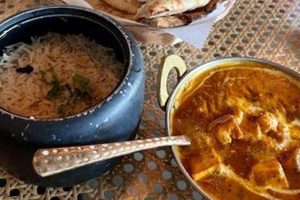The selection of nutritious options when ordering from an Indian takeout establishment involves careful consideration of ingredients, preparation methods, and portion sizes. Certain dishes, characterized by a balance of lean proteins, vegetables, and complex carbohydrates, offer a more health-conscious choice than others. For instance, a lentil-based soup prepared with minimal oil and served with brown rice provides a combination of fiber, protein, and essential nutrients.
Selecting relatively lighter alternatives from a typical Indian takeout menu is beneficial for managing caloric intake and promoting overall well-being. Historically, traditional Indian cuisine emphasized the use of spices and herbs known for their medicinal properties. The integration of these elements, when prepared with mindful attention to healthy fats and low sodium, contributes to a balanced dietary approach. Furthermore, awareness of portion control is a key element in moderating the impact of these foods on individual health.
The following discussion will explore specific menu items available at many Indian takeout restaurants that align with dietary guidelines promoting healthfulness. Consideration will be given to factors such as ingredient profiles, potential modifications for reduced fat or sodium content, and complementary side dishes that enhance the nutritional value of a meal.
Guidance for Healthier Indian Takeout Choices
Selecting optimal choices from an Indian takeout menu requires a discerning approach. The following guidelines offer strategies for making informed decisions that prioritize nutritional value and minimize less desirable components often associated with takeout fare.
Tip 1: Prioritize Lentil-Based Dishes: Lentil-based options, such as dal, provide a source of plant-based protein and fiber. Requesting preparation with minimal added oil can further enhance the dish’s nutritional profile.
Tip 2: Opt for Tandoori Preparations: Tandoori dishes, cooked in a clay oven, are typically lower in fat compared to those that are fried or heavily sauced. Chicken or paneer (Indian cheese) prepared in this manner offers a leaner protein source.
Tip 3: Moderate Saturated Fat Intake: Coconut milk and ghee (clarified butter) contribute significantly to the saturated fat content of many Indian dishes. Inquire about options prepared with alternative cooking oils, or request reduced quantities of these ingredients.
Tip 4: Emphasize Vegetable-Based Sides: Choose vegetable-based side dishes such as saag (spinach), bhindi (okra), or mixed vegetable curries. These offer valuable micronutrients and dietary fiber.
Tip 5: Request Brown Rice: When available, select brown rice over white rice to increase fiber intake and improve the glycemic response.
Tip 6: Control Portion Sizes: Indian takeout portions are often generous. Practice mindful eating and consider sharing dishes or saving leftovers for future meals.
Tip 7: Limit Creamy Sauces: Dishes with rich, creamy sauces, such as butter chicken or korma, tend to be higher in calories and saturated fat. Opt for dishes with tomato-based or thinner sauces instead.
Adhering to these recommendations can facilitate a more health-conscious dining experience when selecting from an Indian takeout menu. By focusing on lean protein sources, vegetables, and mindful preparation techniques, individuals can enjoy the flavors of Indian cuisine while minimizing less desirable nutritional aspects.
The subsequent sections will address strategies for further refining dietary choices and maximizing the overall nutritional value of Indian takeout meals.
1. Lean Protein Sources and Indian Takeout
Lean protein sources represent a critical component in identifying healthier options within Indian takeout cuisine. The nutritional value of a meal significantly increases when lean proteins, such as lentils, chickpeas, tandoori chicken (skinless), or fish, replace or supplement those higher in saturated fat. The inclusion of these protein sources helps manage macronutrient balance, providing satiety and supporting muscle maintenance. The effect is a reduction in overall calorie density and improved nutrient uptake. A real-life example involves substituting a cream-based chicken korma with a tandoori chicken tikka, instantly reducing fat content while retaining flavor and protein. Understanding this substitution is practically significant for individuals seeking to manage weight, blood sugar, or cholesterol levels while enjoying Indian cuisine.
Furthermore, the incorporation of lean protein sources facilitates better blood sugar control, particularly when paired with complex carbohydrates like brown rice or whole-wheat roti. This combination slows down glucose absorption, preventing rapid spikes in blood sugar levels. Dishes featuring lentils or chickpeas, such as dal makhani (prepared with minimal butter or cream) or chana masala, can be modified to enhance their health benefits further by increasing the vegetable content. Another practical application includes choosing fish curries over lamb or beef preparations, given fish’s lower saturated fat content and omega-3 fatty acid profile.
In summary, prioritizing lean protein sources constitutes a pivotal strategy in selecting healthier Indian takeout meals. By consciously making informed choices that favor lean proteins over higher-fat alternatives, individuals can enjoy the flavors of Indian cuisine while aligning their dietary choices with health and wellness objectives. Challenges may arise in identifying precise ingredient lists and preparation methods. However, proactive communication with the restaurant staff can help obtain this information and facilitate more informed and healthful selections.
2. Vegetable-rich curries
Vegetable-rich curries represent a cornerstone of the paradigm of healthier selections within Indian takeout options. Their inherent composition, characterized by a high density of micronutrients and dietary fiber, positions them favorably in relation to overall nutritional value. The incorporation of varied vegetables contributes to a balanced dietary intake and mitigates potential health detriments often associated with takeout fare that is heavy on fats or processed ingredients.
- Micronutrient Density
The abundance of vitamins and minerals in vegetable curries contributes significantly to nutritional adequacy. Vegetables such as spinach (saag), cauliflower (gobi), and eggplant (baingan) provide essential vitamins (A, C, K), minerals (iron, calcium, potassium), and antioxidants. These nutrients play critical roles in maintaining physiological functions, bolstering immune response, and mitigating oxidative stress. A vegetable curry featuring a diverse array of vegetables offers a broader spectrum of micronutrients compared to dishes primarily based on meat or dairy.
- Dietary Fiber Content
Vegetables are primary sources of dietary fiber, which promotes digestive health and contributes to satiety. Fiber adds bulk to the diet, facilitating regular bowel movements and preventing constipation. Furthermore, soluble fiber found in vegetables like okra (bhindi) and lentils can assist in regulating blood sugar levels and lowering cholesterol. The high fiber content of vegetable curries can also aid in weight management by promoting feelings of fullness and reducing overall caloric intake.
- Lower Caloric Density Compared to Meat-Based Curries
Vegetable curries generally possess a lower caloric density than their meat-based counterparts, particularly those prepared with rich sauces containing cream or ghee. Substituting a meat-based curry with a vegetable curry can lead to a reduction in overall caloric intake, supporting weight management efforts. The lower fat content, especially saturated fat, contributes to cardiovascular health. Moreover, vegetable curries often contain fewer added sugars and sodium than processed takeout options.
- Versatility and Customization
The versatility of vegetable curries allows for customization based on individual dietary needs and preferences. Vegetable combinations can be tailored to maximize specific nutrient profiles or address dietary restrictions. For instance, individuals seeking to increase their iron intake can opt for spinach-based curries, while those aiming to boost their potassium levels can choose dishes containing potatoes or sweet potatoes. Furthermore, the spice levels and preparation methods can be adjusted to accommodate individual taste preferences and health considerations.
The facets explored highlight the fundamental importance of vegetable-rich curries within the context of healthier Indian takeout choices. By prioritizing these options, individuals can enhance their micronutrient and fiber intake, manage caloric density, and enjoy a customizable culinary experience that aligns with their health and wellness objectives. The selection of such dishes underscores a commitment to informed dietary choices and promotes a holistic approach to nutrition within the realm of takeout cuisine.
3. Limited saturated fats
The relationship between limited saturated fats and healthful Indian takeout selections is direct and significant. Saturated fats, predominantly found in ghee, coconut milk, and certain animal products commonly used in Indian cooking, exert a notable influence on cardiovascular health. Excessive consumption of saturated fats elevates low-density lipoprotein (LDL) cholesterol levels, increasing the risk of atherosclerosis and subsequent cardiovascular events. Therefore, minimizing saturated fat intake is a key determinant in transforming traditionally rich Indian dishes into healthier options.
Indian takeout menus often feature dishes high in saturated fats. Curries made with coconut milk, such as some kormas and vindaloos, or preparations heavily reliant on ghee, like butter chicken, contribute significantly to the overall saturated fat content of a meal. Conversely, dishes prepared with leaner proteins and vegetable-based sauces, utilizing smaller quantities of saturated fats, represent more health-conscious choices. For instance, selecting tandoori chicken marinated in yogurt and spices over a fried dish or a vegetable curry made with a tomato-based sauce instead of a cream-based one can substantially reduce saturated fat consumption. Requesting modifications, such as asking for dishes to be prepared with minimal ghee or opting for oil-based cooking, further diminishes the saturated fat content. Awareness of ingredients and mindful selection are essential in navigating Indian takeout menus toward healthier outcomes. The practical result of implementing these changes is a reduction in cardiovascular risk and the promotion of overall well-being without sacrificing the enjoyment of Indian cuisine.
In summary, limiting saturated fats constitutes a pivotal element in identifying and enjoying healthful Indian takeout. By understanding the sources of saturated fats in various dishes and actively seeking modifications or alternative preparations, individuals can mitigate potential adverse effects on cardiovascular health. This approach facilitates a balanced dietary approach, allowing the enjoyment of Indian flavors within the parameters of a health-conscious lifestyle. Challenges in determining precise ingredient composition in takeout meals may require proactive communication with restaurant staff to obtain necessary information.
4. Fiber-rich carbohydrates
The inclusion of fiber-rich carbohydrates is a crucial element in the discussion of optimal choices from Indian takeout menus. These carbohydrates contribute to satiety, promote digestive health, and provide sustained energy release, offering a nutritional advantage over refined carbohydrate options. Their selection represents a strategic consideration in formulating a balanced and health-conscious meal plan.
- Satiety and Appetite Control
Fiber-rich carbohydrates, such as brown rice, whole-wheat roti, and lentils, exhibit a higher satiety index compared to refined carbohydrates like white rice or naan. The increased fiber content slows gastric emptying, promoting a feeling of fullness and reducing the likelihood of overconsumption. This mechanism is particularly relevant in the context of takeout meals, where portion sizes often exceed recommended levels. Selecting fiber-rich options can aid in appetite control and contribute to weight management efforts. For example, choosing brown rice instead of white rice with a vegetable curry provides sustained energy and reduces the likelihood of post-meal hunger.
- Digestive Health and Gut Microbiome
Dietary fiber plays a vital role in promoting digestive health and supporting a balanced gut microbiome. Fiber adds bulk to the stool, facilitating regular bowel movements and preventing constipation. Furthermore, certain types of fiber, such as resistant starch found in lentils and legumes, serve as a prebiotic, nourishing beneficial gut bacteria. A healthy gut microbiome contributes to improved nutrient absorption, enhanced immune function, and reduced inflammation. Incorporating fiber-rich carbohydrates into Indian takeout meals supports digestive well-being and promotes a healthy gut environment. For instance, a lentil-based dal served with whole-wheat roti provides both soluble and insoluble fiber, contributing to optimal digestive function.
- Blood Sugar Regulation
Fiber-rich carbohydrates have a lower glycemic index compared to refined carbohydrates, resulting in a slower and more gradual release of glucose into the bloodstream. This characteristic is particularly beneficial for individuals with diabetes or insulin resistance, as it helps prevent rapid spikes in blood sugar levels. The sustained energy release provided by fiber-rich carbohydrates contributes to improved blood sugar control and reduces the risk of energy crashes. Opting for brown rice or whole-wheat roti over white rice or naan can help stabilize blood sugar levels and promote overall metabolic health. For example, a vegetable biryani prepared with brown rice and a variety of vegetables offers a balanced combination of complex carbohydrates, fiber, and micronutrients, contributing to improved blood sugar regulation.
- Nutrient Density and Micronutrient Provision
Fiber-rich carbohydrates often provide a broader spectrum of essential nutrients and micronutrients compared to refined carbohydrates. Whole grains, legumes, and certain vegetables contain vitamins, minerals, and antioxidants that contribute to overall health and well-being. For instance, brown rice is a source of magnesium, selenium, and B vitamins, while lentils are rich in iron, folate, and potassium. Incorporating these nutrient-dense carbohydrates into Indian takeout meals enhances the nutritional value of the meal and supports optimal physiological function. Choosing dishes that feature a combination of whole grains, legumes, and vegetables ensures a diverse intake of essential nutrients.
In conclusion, the strategic selection of fiber-rich carbohydrates represents a key component in formulating health-conscious Indian takeout meals. The benefits of satiety, digestive health, blood sugar regulation, and nutrient provision underscore the importance of prioritizing these carbohydrate sources. By consciously choosing options like brown rice, whole-wheat roti, and lentil-based dishes, individuals can enhance the nutritional value of their takeout meals and support their overall health and well-being. The implementation of these dietary strategies exemplifies a proactive approach to nutrition and demonstrates a commitment to making informed choices within the context of takeout dining.
5. Smaller portion sizes
The connection between smaller portion sizes and selecting healthful Indian takeout stems from the inherent energy density of many traditional dishes. Indian cuisine, while flavorful and diverse, often incorporates ingredients high in fat, carbohydrates, and sodium. Consuming these dishes in oversized portions negates the benefits of even the most carefully selected ingredients. The caloric surplus associated with large portions contributes to weight gain, elevated blood sugar levels, and increased risk of cardiovascular disease. Thus, portion control is a critical factor in mitigating the potential negative health impacts of Indian takeout and promoting overall well-being. For example, a single serving of biryani can easily contain over 1000 calories; reducing the portion to half substantially decreases the caloric intake.
Practical application of portion control in Indian takeout involves several strategies. Individuals can proactively request smaller serving sizes when placing orders. Sharing dishes with others provides a means of reducing individual consumption. Utilizing smaller plates at home reinforces visual cues for appropriate serving sizes. Saving leftovers for subsequent meals prevents overeating during a single sitting. Furthermore, awareness of recommended serving sizes for various food groups is essential. One cup of rice or a palm-sized serving of protein represents a reasonable portion for many individuals. Employing these techniques allows for the enjoyment of Indian cuisine without compromising health goals. Choosing smaller portions of vegetable-rich curries alongside a limited serving of brown rice constitutes a significantly healthier option than consuming a large portion of a cream-based meat curry with naan.
In summary, the practice of consuming smaller portion sizes is intrinsically linked to achieving a healthful approach when enjoying Indian takeout. It serves as a mitigating factor against the energy density and potentially detrimental ingredients prevalent in many dishes. While selecting nutritious ingredients is important, portion control acts as a necessary complement to manage overall caloric intake and promote positive health outcomes. Challenges may arise in resisting the appeal of large portions and cultural norms associated with abundant food. However, the implementation of mindful eating habits and awareness of appropriate serving sizes can overcome these obstacles, leading to a more balanced and sustainable approach to enjoying Indian cuisine within a health-conscious lifestyle.
Frequently Asked Questions
The following addresses common inquiries regarding the selection of healthful options from Indian takeout establishments. It aims to provide clear, evidence-based guidance for informed dietary choices.
Question 1: Are all Indian takeout options inherently unhealthy?
No. The assumption that all Indian takeout is unhealthy is inaccurate. While some dishes are high in saturated fat, sodium, and calories, careful menu selection and portion control can yield nutritious and balanced meals.
Question 2: What specific dishes should be avoided to minimize saturated fat intake?
Dishes containing significant amounts of ghee (clarified butter), coconut milk, or cream, such as butter chicken, korma, and malai kofta, are typically high in saturated fat and should be consumed in moderation, if at all. Alternatives include tandoori preparations and vegetable-based curries with tomato-based sauces.
Question 3: Is brown rice always a healthier choice than white rice at Indian takeout restaurants?
Generally, yes. Brown rice offers a higher fiber content and a lower glycemic index compared to white rice. This contributes to improved satiety, better blood sugar control, and enhanced digestive health. However, portion control remains important, regardless of the rice type.
Question 4: Can lentil-based dishes be considered a good source of protein in Indian takeout?
Yes. Lentil-based dishes, such as dal, are a valuable source of plant-based protein and fiber. They contribute to satiety and support muscle maintenance. Requesting preparation with minimal added oil can further enhance their nutritional profile.
Question 5: How can sodium content be managed when ordering Indian takeout?
Sodium levels can be high in many Indian takeout dishes. Requesting that the kitchen use less salt during preparation is one strategy. Selecting dishes with fresh ingredients and minimal processed sauces also helps. Drinking plenty of water can assist with sodium excretion.
Question 6: What is the most effective strategy for managing portion sizes with Indian takeout?
Several methods exist. Ordering smaller portion sizes, sharing dishes with others, using smaller plates at home, and saving leftovers for future meals are all effective. Being mindful of serving sizes and avoiding overconsumption are key components.
In essence, the selection of healthful Indian takeout options requires informed decision-making and mindful consumption habits. Awareness of ingredients, preparation methods, and portion control is paramount.
The subsequent sections will provide strategies for adapting common Indian dishes to better align with dietary guidelines.
Healthiest Food from Indian Takeaway
The preceding exploration of “healthiest food from indian takeaway” has elucidated various strategies for making informed dietary choices. By prioritizing lean protein sources, emphasizing vegetable-rich curries, limiting saturated fats, selecting fiber-rich carbohydrates, and adhering to smaller portion sizes, individuals can enhance the nutritional profile of their Indian takeout meals. These considerations represent a holistic approach to balancing culinary enjoyment with health-conscious decision-making.
The ongoing application of these principles contributes to sustained well-being. Continued awareness of ingredients and preparation methods, coupled with proactive communication with food service providers, remains crucial for optimizing dietary choices within the realm of Indian takeout. Ultimately, the informed selection of healthier options promotes a harmonious integration of cultural culinary traditions with personal health objectives.







